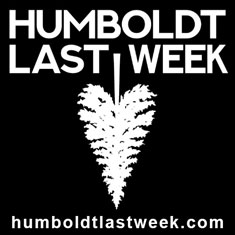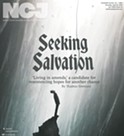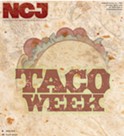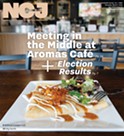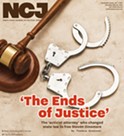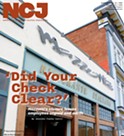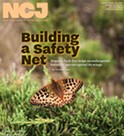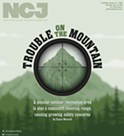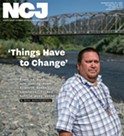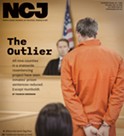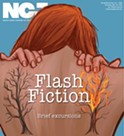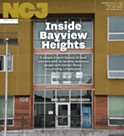Bridgeville
The strange past and uncertain future of a small town for sale
By Linda Stansberry [email protected] @lcstansberry[
{
"name": "Top Stories Video Pair",
"insertPoint": "7",
"component": "17087298",
"parentWrapperClass": "fdn-ads-inline-content-block",
"requiredCountToDisplay": "1"
}
]
It's the third Friday of the month, and volunteers at the Bridgeville Community Center are busy. The community center's food pantry feeds around 60 families from neighboring communities. On other days, it offers adult education, mental health referrals and a senior lunch. For those accustomed to larger burgs, the tiny town — 83 acres, population 25, halfway between Fortuna and Ruth Lake on State Route 36 — may seem like the middle of nowhere, but for many in this rural part of Humboldt County it's the center of everything. And for decades, as the town has gone from owner to owner, in and out of escrow, across international headlines and through the dreams of ministers and music producers, locals have waited for that center to drop out.
"It's just kind of in limbo," says Chantal Campbell, liaison for the community center. "It's hard to think about somebody privately buying it and turning it into their own thing when we want to make it a community."
The town, which gained widespread media attention in 2003 when it went up for sale on eBay, has been under absentee ownership for the past 10 years, managed remotely by the family of its previous owner, who died in 2006. The family's realtor says they hope to get $995,000 for the town, about $200,000 less than its last sale price. At one time, Bridgeville was a thriving waystation for stagecoaches, its eponymous bridge the only overland route south out of Humboldt County. The establishment of the railroad connecting Humboldt Bay with San Francisco, then the Redwood Highway, made the once-essential route obsolete. But even as the world withdrew from Bridgeville, the tiny collection of buildings perched on the edge of the Van Duzen River became the backdrop for the fantasies of outsiders wanting to get away from it all.
Jessie Wheeler has fond memories of a childhood in Bridgeville, which her great-grandparents bought in 1912. At the time it boasted a hotel, livery, blacksmith, store, school and post office. The town weathered the end of the stagecoach years and the collapse of the wool market, finding its footing during the timber boom of the 1940s and 1950s. Wheeler's grandfather, George Henry Cox Jr., erected small pre-fab homes for lumberjacks and their families. Many were from Oklahoma and Arkansas, having fled the Dust Bowl. When Wheeler went to board at the convent in Eureka for her high school years, the nuns had to train her out of using an "Okie drawl." Dances at the town hall, deep-pit barbecues and an annual rodeo drew revelers from neighboring communities. The town's finances hinged on wages earned from the mills, with the Cox family drawing in profits from the store and rent. Wheeler said her grandfather was a kind but modest man. He had one house specially made for a World War II veteran who had lost his legs in combat. It was, Wheeler says, the first and last ADA-accessible home in Bridgeville.
"It was a fully functional little town," Wheeler says. In her folder full of historic photographs, there's a newspaper clipping from March of 1961, announcing the installation of streetlights. It could be argued that the construction and functionality of Bridgeville could only have existed for this brief window of time, when the timber market was strong and environmental regulations weren't. Because of its adjacency to the river, Wheeler says, the soil would never pass a percolation test necessary to install a full sewer system. Residents used to draw water from the river during dry summer months, something that is now neither legal nor advisable. The Cox family negotiated water rights through handshake deals with local ranchers to pump springwater out of the hills, but there has never been a community services district or water treatment plant for the town.
Wheeler's mother, Laura June Pawlus, inherited Bridgeville from her parents in 1966. By then the timber boom had subsided and Pawlus — who had been caring for her aging parents — found herself unable to keep up with the work of the town. She became postmaster at the little post office to make ends meet. In 1973, she sold Bridgeville for $150,000 to a family from San Francisco — the Lapples.
"That was the saddest thing that ever happened to Bridgeville," Wheeler says. "They tried to take over everything and just let it go downhill."
Calls to Elizabeth Lapple, owner of the Eureka-based glassware business Stuff N'Things and former owner of the town (inherited from her mother, also named Elizabeth Lapple), went unreturned, but a 1978 newspaper article in The Day (a Connecticut paper) seems to confirm Wheeler's accusation that the family had failed to maintain the town. Residents called the houses "seamy" and reported being "often without plumbing or sewage." Wheeler says this is because the Lapples had burned their bridges with neighboring ranchers, removing pipelines and failing to cement the handshake agreements her grandfather had established over water access. The Lapples, it would appear, were the first of Bridgeville's many owners who had enough money to purchase the town, but not nearly enough to maintain it.
"People think, 'Oh I'm buying my own town, I'll have my own zip code,'" Wheeler says. "They don't know what it takes."
Wheeler and others say that around this time drugs began washing through the town. Laura Pawlus, still the postmaster, called federal agents when she suspected controlled substances were being sent through U.S. Mail. The article in The Day describes the tenants during the Lapple period as people who offended their conservative rancher neighbors because "they did not work and because many of them had long hair and beards and shunned marriage." Wheeler, who lived in Sonoma, would drive straight through Bridgeville when she returned to visit her mother, who lived across the river. The house her grandparents had built up from a one-room cabin had its windows broken, its lawn covered in junk.
"It was awful," she says.
In 1977, the Lapples sold the town for the first time, to a religious group from Fremont called the Full Gospel Temple, also known as the Pentecostal Faith Challengers. Made up of mostly elderly people who had put their life savings into buying the town, the group intended to create a "religious community in the wilderness." They evicted Bridgeville's tenants, which endeared them to some of the local ranchers, but also banned the sale of spirits and tobacco at the store and saloon, which apparently endeared them to no one and cut dearly into the town's revenue. The town sold for $450,000, according to The Day. The Lapples retained the title on the town, and when the order's minister took the kitty and absconded in the middle of the night ("Got a calling," says Wheeler), the mortgage came due and the elderly congregants were foreclosed upon.
The Lapples had at least one other buyer after this, another minister who planned to start a home for wayward boys, but he, too, struggled with the ongoing infrastructure issues and never saw his dream come to fruition. Even as plans were being made to rescue impoverished outsiders, the region was experiencing growing pains due to a changing demographic, the further decline of the timber industry and the burgeoning marijuana trade. In 1991, citizens began meeting for potluck dinners to discuss the problems facing at-risk youth in the area. Over a third of local households lived below the poverty line, and many children were receiving inadequate medical care. Issues affecting children, such as hard drug use and emotional and physical abuse, were going unreported due to the fear of marijuana eradication raids. In 1994, Bridgeville received a three-year, $400,000 Healthy Start Implementation Grant from the State of California. The grant helped jumpstart the community center, which has brought in a number of resources, including a children's outreach coordinator.
In 2003, Elizabeth Lapple decided to put Bridgeville up for sale on eBay. By this time there were no businesses in the town, just a handful of houses in poor repair and the tiny post office. (The school is county property and was not included in the sale.)
''Bridgeville is the perfect thing. You can have control of the town, everyone who lives there, and you can have your own little paradise away from Los Angeles," Lapple told the New York Times Magazine at the time, adding that the notoriety the sale attracted was not all welcome. "I've had nine marriage proposals since the sale."
While the novelty of putting a town for sale on eBay garnered plenty of publicity and offers of all kinds, it didn't actually produce a buyer. The highest bidder — who offered $1.77 million — later backed out of the sale, and a real estate developer from Los Angeles named Bruce Krall snatched the town up for $700,000 in 2004. Wheeler says Krall was a "nice, nice man" who consulted her before the sale.
"He got ahold of me and asked me what ... to worry about. I told him, 'water and sewage'," she says. And Krall — who planned to turn Bridgeville into an upscale health retreat — did make some long-needed infrastructure repairs, including fixing roofs on the remaining houses, tearing down the dilapidated grocery store and installing a septic system for the town's post office. But ultimately, Krall couldn't align his vision with the reality of living so far away from the life his family had established in L.A., and he put Bridgeville back on eBay. Krall died in a private plane crash in 2011.
In 2006, a 25-year-old entertainment manager named Daniel La Paille, also from Los Angeles, bought Bridgeville for $1.25 million. He, too, had big plans, including putting in a hotel. But mere months after the purchase, he committed suicide, returning the town to limbo. La Paille's family in Riverside retained ownership and Bridgeville has been for sale ever since.
"It's hard to manage a property from 600 miles away," says Bruce McNaughton, the La Paille family's real estate agent. "Plus, it keeps bringing up the tragedy that happened to their son."
McNaughton says the family has been doing some of the necessary maintenance on the town over the last 10 years, such as digging a well and remodeling the old church. Most of the day-to-day has fallen to a caretaker who lives in the town, and the rental income, while low, helps the town "sort of pay for itself." Although several buyers have expressed interest over the last few years, and the property has even gone into escrow a few times, all have pulled out after doing the math.
Most of the work that has been done in Bridgeville over the past few decades has been demolition. Both the Cox home and the little yellow house that Henry Cox built for his veteran friend have been torn down. "No Trespassing" signs adorn the walls and fences of what remains. Five of the remaining eight are inhabited; their vacant neighbors sit abandoned, with broken windows, overgrown by blackberry brush. The town's historic bridge, which was designed by John B. Leonard, the same engineer who designed Fernbridge, was decommissioned in 1997, and officially dedicated to Henry Cox. Once a vital link between Humboldt County and the outside world, it now deadends onto a gravel pit and the edge of State Route 36. On one of its far parapets, the date of its erection — 1925 — is etched just opposite a scrawl of graffiti. At the time the Journal went to print, Bridgeville's listing had been temporarily put on hold, although McNaughton could not say why, only that the La Paille family was "figuring stuff out."
Many locals still have high hopes for the town, where the school and community center still serve as gathering places for families from even tinier burgs. The rental market in the area is highly impacted, and many families who would like to keep their children at Bridgeville School have been forced to move to town. Some envision the old churchyard next to the bridge as a community park. Currently it — and everything in the town except for the bridge, post office and school — are off limits for liability reasons.
Local historian Jerry Rohde, whose next book will include a chapter about the town, says Bridgeville's fate is identical to many former boom towns in the Humboldt hills and tightly tied to the region's changing demographics and income. Some former company towns, such as Samoa, have found rescue in the form of private developers. Others, like Scotia, have been rezoned with plans to sell homes off to private citizens. But in Bridgeville, he says, the good times are not coming back.
"The most they can hope for now is just being a gathering place for the few locals there are," he says. "As far as being a community, I just don't see it happening anywhere in those outlying communities. Now there are so many people out there making good money growing marijuana, they may not even live there year-round. There are people and there's wealth, but it doesn't translate to supporting a small local community. Unless you had some group of people who wanted to form one of those intentional communities, that had some reason for wanting to be together, close to hand, I don't see where the motivation would be there for it to bounce back and be vital to the local area."
Jennifer Bishop, who homesteads 7 miles away off State Route 36 and whose daughter attends school in Bridgeville, disagrees. Bishop, who started the town's annual UFO festival Bridgefest, feels the sole-owner model that has been in place for most of the town's history is at the root of its dysfunction, and that with sufficient money and drive it could be revitalized as a community hub serving the ranchers, homesteaders and marijuana growers in the surrounding hills. Bishop began the Bridgeville Improvement Group (B.I.G.) in the last several years, and has been researching cooperative housing models that she feels would work for the town.
"If there were 10 people with $200,000 apiece that formed an investment group who wanted to build housing and businesses, we could make it happen," she says. "It's so expensive for one person to maintain and redo — we need multiple hands."
B.I.G., which consists of Bishop and one or two other locals, has been working to find those 10 people for two years. They would have to be 10 "magical people," she admits, people who were interested in investing for the common good, people who had a special alchemy of wealth, patience, diligence, altruism and vision. The money for potential business owners is there, she insists, especially during the harvest season. Seventeen miles away, the nearby Dinsmore Store is "clogged" during the summer and fall, with seasonal workers looking for soil and sustenance. A Brinks truck comes to take the store's till every week. If someone were to open a laundromat, a restaurant or a store in Bridgeville, he or she could easily capitalize on the money that's currently "flying out the door, to Costa Rica or Hawaii," and reinvest it back into infrastructure, she says.
But actually getting a return on investment would take time and elbow grease. None of the buildings currently standing on the town's lone road could be brought up to code. Not only are they in an extreme state of disrepair, the Van Duzen's designation as a Wild and Scenic River brings the adjacent area under national protection, making the permitting process for any new construction a nightmare. Bishop, who says she has done "way too much research," says the new construction would have to be moved "up the hill" and away from the water, but after that, the possibilities are endless. The old church could be a community hall, the churchgrounds a park. It would be a walkable community, a place where people know their neighbors, a model of energy-efficiency and the power of local investment. Yes, she admits, she, too, has been "bitten by the Bridgeville bug."
The best metaphor for Bridgeville might be its tiny cemetery, which sits on the hill next to the road headed east out of town, a white picket fence frames a view of the fog-draped mountains. Inside, cracked stone markers have been repaired and propped upright on the muddy ground, which is slouching slowly but inevitably into the river. Patriarchs from the 19th century rest shoulder-to-shoulder with stillborn babies interred during the hazy 1980s, waiting for a patient hand to pluck the weeds and still the sliding earth. Because this town, like all towns, is more than a zip code and a main street. It's the monuments and the history, paint chips and black mold, water running through the hills and thrumming below the pavement; it's those who own it, those who use it and those who call it home. Whoever buys Bridgeville next will have to serve them all, the living and the dead.
Comments (9)
Showing 1-9 of 9
more from the author
-
Lobster Girl Finds the Beat
- Nov 9, 2023
-
Tales from the CryptTok
- Oct 26, 2023
- More »
Latest in News
Readers also liked…
-
Through Mark Larson's Lens
A local photographer's favorite images of 2022 in Humboldt
- Jan 5, 2023
-
'To Celebrate Our Sovereignty'
Yurok Tribe to host gathering honoring 'ultimate river warrior' on the anniversary of the U.S. Supreme Court ruling that changed everything
- Jun 8, 2023






